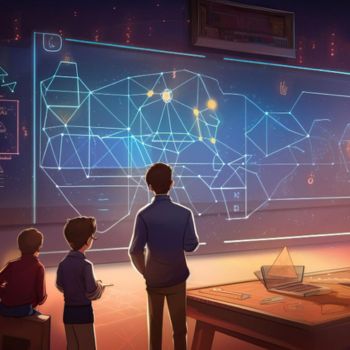Enrich teaching and learning experiences by seamlessly integrating digital technologies in classrooms. Check the details below!
The integration of digital technologies in the classroom has revolutionised the way educators teach and students learn. By embracing these new tools, teachers can enhance engagement, personalise learning experiences, and prepare students for a digitally-driven world.
Everything from Diwali to traditional Raksha Bandhan design activities was disrupted by the widespread lockdowns and school closures caused by the pandemic. This meant teachers had to take an innovative approach to educating, rushing into modern technologies to create a remote and digital classroom. As a result, those digital elements have become mainstays in the modern classroom, even with students returning to their regular schedules.
That has also created challenges for the modern teacher, trying to understand which technologies are essential for the development of their students. Here are eight easy methods for teachers to integrate digital technologies into their classrooms.
The days of messy chalkboards are gone for most teachers, with internet-connected whiteboards unlocking new levels of creativity, engagement and interactivity for students of all ages.
The modern whiteboard ignites all of the senses, incorporating sound, video and movement along with the ability to touch and create the elements on display. A Participatory Educational Research report carried out by the Department of Education found that these interactive whiteboards generated a 130% increase in student motivation. In contrast, teachers reported creating time efficiencies and making it easier for their students to learn in the classroom environment.
Learning should not be boring, or students will tune out, fail to absorb information and possibly become restless and disruptive. Incorporating fun into the learning process is essential, and digital technologies unlock ways to bring new learning experiences to the classroom.
Example. These fun and interactive educational games unlock a child’s imagination and will get them engaged in the learning process, even when they have been resistant to traditional learning.
Traditional excursions or field trips are fun and educational but expensive, time-consuming and disruptive to the regular curriculum. Digital technologies allow educators to take their students on eye-opening adventures around the world without ever having to leave the classroom.
Modern museums and libraries offer interactive experiences, and virtual reality devices allow for new ways to interact with other cultures around the world. Google Earth can transport students anywhere in the world, providing a rich, sensory experience that books cannot provide.
Teamwork makes the dream work. Online collaboration platforms give students more opportunities than ever to develop teamwork skills by working on projects together – even when they are not in the same room as each other. These tools have been reported to improve productivity by 30%, assist with developing peer-to-peer learning, get students more engaged in projects and also allow educators greater scope to send and receive content to students online.
Educators have also reported that their teaching has improved as a result of online collaboration platforms because it gave them access to new resources, allowed them the opportunity to try new ideas and also developed a greater sense of accountability. Collaborative learning doesn’t stop with students – you may find you pick up some extra skills too.
We have come a long way since the days of presenting information on static pieces of cardboard with images cut from books or magazines. PowerPoint made digital presentations more accessible to students, and new technologies are taking this to new levels, allowing teachers and students to embed videos, images, polls, scenarios and other interactive content into their presentations. Rather than sitting through someone lecturing for 10 minutes, multimedia presentations allow for a more engaging experience for students and allow teachers to use active learning techniques to inspire everyone in the classroom.
By giving students an immediate snapshot of their performance across all subjects, they can take accountability for their own learning through visual indicators of their progress throughout the year. Teachers are able to use data from digital portfolios to provide personalised education experiences and also discover areas where individual students need assistance, as well as where the entire class might be struggling so improvements can be made.
There are so many reasons to include blogs in the classroom, with benefits on offer for both teachers and students alike. The primary benefit is obvious: it creates a fun and engaging way to get students – especially younger ones – to read, write, and develop their communication skills.
As they improve, students can then get their blog content published, first internally through school newsletters, online publications and for school projects. Teachers can use blog platforms to their benefit as well, using them to communicate information like important dates, assessment details and resources for parents, students and other colleagues to easily access.
In the past, teachers, students, parents and stakeholders would not know the progress of each child until all assessments had been completed and graded. Formative assessment tools have transformed this, creating a portal where all stakeholders can see the ongoing progress of each student and the classroom and school as a whole. This means that teachers can intervene quickly if a child is falling behind in any subject, ensuring better results across the board and an improved, personalised approach to learning for all students.
Furthermore, it can be more encouraging for a student to see their abilities as an ever-changing work in progress rather than a static mark. Having the ability to edit portfolios as improvements are made will motivate your class to keep pushing harder as they see what they’re achieving.
In conclusion, the world of digital technologies should not be viewed as daunting for the modern teacher. Instead, see them as having the potential to unlock incredible new ways to teach and involve students in ways that were never possible before. By embracing these innovations, the modern teacher can bring out the best in their students and make teaching fun and interactive for all to enjoy.
